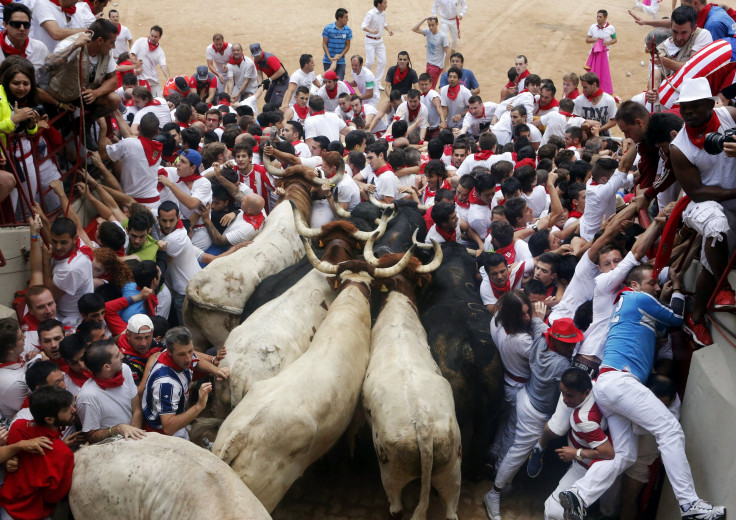San Fermin 2013: Several Bull-Runners Gored Over Final Weekend

A Miura bull gored and seriously injured a 23-year-old Australian woman Sunday in the final running of the bulls at the 2013 San Fermin Festival in Pamplona, Spain. Her injury capped a bloody end to the festivities, where critics say big thrills and high alcohol consumption once again trumped common sense and ethics.
The woman, identified only by the initials J.E., suffered multiple rib fractures and damage to her right lung after being speared by one of the half-ton animals as she clambered to safety over a barrier near the entrance to the bullring. The regional government, organizer of the festival, said she was in “very grave” condition Sunday at Navarra Hospital. She was joined by four others who were also injured in Sunday’s bull run.
The Australian is one of just five women to have been gored at the annual fiesta since officials lifted a ban on female participants 39 years ago. Yet her injury is hardly uncommon. Each year, between 200 and 300 participants are hurt, about 3 percent seriously, mostly from being trampled on or gored by the Miura bulls. The animals -- weighing as much as 600 kilograms (1,320 pounds) -- chase the red- and white-clothed participants through a winding 849-meter (928-yard) course to the city bullring each morning of the nine-day celebration.
The 2013 San Fermin Festival’s bloody final weekend began Friday, when the bulls gored three men, including an American who had emergency surgery to remove his spleen. Another American was hospitalized and was said to be recovering favorably from a “rectal perforation.”
On Saturday, a 19-year-old Spaniard was left in “very serious” condition after he was trampled when runners fell and piled up at the entrance to the bullring. Some 200 others were caught up in the stampede, which injured a total of 23 participants when two of the bulls leapt atop the pile.
Although San Fermin had many near-death escapes, there were no fatalities this year. At least 15 people have been killed at the festival since records began in 1911, including 27-year-old Madrid native Daniel Jimeno, who passed away in 2009 when a bull named Capuchino gored him in the neck.
San Fermin was immortalized in Ernest Hemmingway’s “The Sun Also Rises” and gained global recognition thereafter, but is perhaps best known today for the dramatic images and graphic attack videos broadcast on Spanish television and beamed around the world. The revelers’ uncertain fate heightens the drama, although the bulls’ final destination is predetermined. They’ll end up in the bullring at the end of the cobbled course where they’ll meet their deaths at the hands of a matador.
It is for this reason -- as well as the poking and prodding that gets the bulls fired up for each run -- that many activists abhor the San Fermin Festival, which honors the patron saint of Pamplona and attracts as many as 2 million tourists to the northern Spanish city each year, including thousands from the U.S., Australia and Britain. Organizations such as PETA and AnimaNaturalis say the 2,000-3,500 participants who line up each morning to run with the bulls unwittingly condone animal cruelty.
Others, including Spain’s Prime Minister Mariano Rajoy, disagree. Despite the sport’s waning popularity among Spaniards, Rajoy has vowed to make bullfighting part of Spain’s “national patrimony” and secure more funding to ensure its long life.
© Copyright IBTimes 2024. All rights reserved.






















